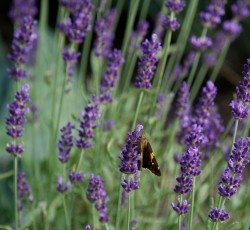
Basket of Gold
Aurinia saxatilis
These sweet-smelling golden flowers are ideal for the front of the border in spring when bulbs are blooming.

These sweet-smelling golden flowers are ideal for the front of the border in spring when bulbs are blooming.

A cottage garden favorite, black-eyed susan features masses of ferociously yellow flowers that attract butterflies. They are incredibly hardy and tolerate a wide variety of conditions, making them ideal for naturalizing.

This unique plant features bright blue-purple flowers on tall green stalks followed by interesting black seedpods. It forms a deep taproot and does not transplant well, so be certain of its location before planting.

This plant features brilliant orange flowers that light up the garden and are attractive to pollinators, including monarchs and honeybees.

Spires of pink and white bracts crown this large-leafed salvia. It has been used as an herb since the Middle Ages and is currently used as flavoring for wines, vermouth, and liqueurs.

Fragrant spires of dark purple flowers above silvery foliage light up the garden border in summer. If trimmed after blooming, they will flower again. Their flowers may be used in sachets or as flavoring in baking and drinks.

An unusual flower for the summer garden, these blue thistle-like blooms add a unique texture. If cut back after blooming, they will send up new flowers. They make excellent dried and cut flowers.

This versatile hydrangea tolerates a wide variety of conditions and is ideal for borders or natural areas. It benefits from an annual pruning in late winter to prevent the heavy blooms from flopping.

Jerusalem artichoke is a perennial sunflower relative that produces a profusion of bright yellow flowers atop ten foot stalks. It is valued for its edible tubers, which resemble the flavor of water chestnuts.

This silver-leafed groundcover does best in well-drained soil, but tolerates adverse conditions. Its purple flowers are attractive to honeybees and bumblebees.

Oregano is a compact slow-spreading herb that is popularly used in cooking. It is very fragrant and attractive to bees and butterflies.

Persimmons are an unusual American fruit that can colonize in abandoned fields and open woods. Female trees bear astringent orange fruits that become fully ripe after a frost.

This native perennial has vibrant magenta flowers which add contrast to the overwhelming yellows and reds of the summer garden. The showy daisy-like flowers borne on stiff stems attract goldfinches if left to go to seed.

Rose campion features soft silvery mounds of foliage graced with stalks of stunning pink or white flowers in the late spring and early summer. This short-lived perennial or biennial self-seeds readily, forming large colonies if left unchecked.

Sage is a woody subshrub with silvery green leaves and pale purple flowers that are attractive to butterflies and other pollinators. It does best in well-drained, sunny locations. For centuries, sage has been a popular herb for cooking, and is also used as an essential oil.

Featuring airy foliage and golden flowers, this native plant is an attractive addition to the front of the border. It spreads by runners and is easily divided to share with your friends and neighbors. It is native to Fairfax County, Virginia.

A small, woody sub-shrub, thyme has aromatic leaves and whorls of pink flowers in early summer. It is popularly used as an edging and between stones in walkways. It is also an excellent culinary herb.

Wallflowers are a charming spring bloomer of exceptional hardiness. With yellow and red flowers, this cheerful annual adds vibrancy to the front and middle of the flower border.

White oaks are well known for their distinctive silhouette. They are massive trees which provide excellent shade as well as habitat for birds and other wildlife. Their acorns are especially attractive to deer and squirrels.

A more delicate species than its red-flowered cousin, bergamot has lovely lavender flowers and a more graceful look. It is attractive to bees, butterflies, and hummingbirds.